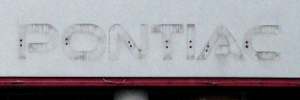















Enjoy a Quality and Comfortable Ride with a Pontiac Shock |
|---|

|
Anthony Fontanelle
September 18, 2007
Control, handling and comfort are some of the things we look for in a vehicle. Whether it is for a short drive or a long trip we want to be comfortable even when driving through rough roads. And we expect the drivers to be able to handle drives over bumps, road cracks and off-roads that are not paved. We also know how much bumps on rough and uneven roads would affect our most treasured vehicle, whatever that may be. Shocks, which are usually found on the rear of some front-wheel drive vehicles, are the components that ensure our drive is as comfortable as possible. Pontiac Shock slows down and reduces the magnitude of vibratory motions by turning the kinetic energy of suspension movement into heat energy which can be dissipated through hydraulic fluid. These auto parts are typically employed on vehicles using standard suspension systems.
The shock is also known as the shock absorber and it functions to curb the unwanted movement of the vehicle’s springs as they compress and rebound while the car is running in a process called dampening. Without the Pontiac Shock, it would be so hard to control the car especially as there will be so much bouncing. When the vehicle’s wheel encounters a bump and causes the spring to coil and uncoil, the energy of the spring is transferred to the shocks and to the piston through the rod. The Pontiac Shock delivers resistance by forcing hydraulic fluid through the piston valves as it goes up and down. But oil is incompressible so only a particular amount of fluid is forced through the piston valves. This generates the resistance to the movement of the vehicle especially on uneven and irregular road by slowing down the piston which in turn slows down the spring. The shocks also ensure that the tires are constantly connected to the road because it has a very strong effect on the handling of the car. The Pontiac Shock work in two cycles – the compression cycle and the extension cycle. The compression cycle happens when the piston moves downward and compresses the hydraulic fluid in the chamber below the piston. The extension cycle happens when the piston moves upward and compressing the fluid in the chamber above the piston. There is more resistance during its extension cycle than its compression cycle. The extension controls the heavier sprung weight while the compression controls the vehicle’s unsprung weight.
There are different kinds of shocks and some of them are the premium and the regular hydraulic shock. The premium which contains nitrogen gas is basically superior to the hydraulic shocks with air simply because the nitrogen prevents the formation of bubbles which is possible with air. Formation of bubbles reduces the ability of the shock to give resistance and prevent bounces. Nitrogen gas also hastens the response of the shocks movement increasing comfort and control. All Pontiac Shock are velocity-sensitive meaning the faster the suspension moves the more resistance is provided by the shocks. This enables the shocks to adjust to the road conditions and control all the unwanted motions of a moving vehicle including bouncing, swaying, brake dive and acceleration squat.
Source: Amazines.com
